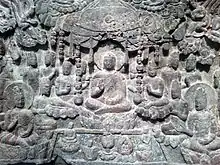Xiangtangshan Caves
The Xiangtangshan Caves (simplified Chinese: 响堂山石窟; traditional Chinese: 響堂山石窟; pinyin: Xiǎngtángshān Shíkū; lit. 'Mountain of the Echoing Halls Caves') is a group of Buddhist cave temples located in the Fengfeng Mining District about 20 km to the southwest of the City of Handan, in Hebei province, China. The oldest cave temples in the group date to the Northern Qi, one of the Northern dynasties in the sixth century, and were sponsored by the dynasty's court. The caves are located about 20 km to the northwest of the site of Ye, the capital of the Northern Qi and were carved into dense limestone cliffs on mountains that are part of the Taihang Mountains.[1]

Description and background
There are a total of 36 caves, clustered in three groups: a northern group (Chinese: 北响堂山; pinyin: Běi Xiǎngtángshān) on Mount Gu (Chinese: 鼓山; pinyin: Gǔshān; lit. 'Drum Mountain') near the village of Hecun; a southern group (Chinese: 南响堂山; pinyin: Nán Xiǎngtángshān) on Mount Fu; and a site at Shuiyusi that is also known as "Little Xiangtangshan" (Chinese: 小响堂山; pinyin: Xiǎo Xiǎngtángshān). The northern group contains three main caves, the northern cave (cave 7), the central cave (cave 4), and the southern cave (cave 2). According to one historical source, writings by the monk Min Fen, the northern cave group was commissioned by Wen Xuan, the first Northern Qi emperor. The largest cave in the group (the northern cave or cave 7) may have served as the emperor's burial site. Construction of the caves in the southern group started at the initiative of a monk, Hui Yi of the Linghua temple, in 565. The project was continued under the sponsorship of Gao Anahong, the king of Huai Ying and one of the highest official in the Northern Qi dynasty. Work on the southern caves likely ended around the time when the Northern Qi was annexed by the Northern Zhou in 577.[1] Since they were not sponsored by imperial patrons, the caves in the southern group tend to be smaller than those in the northern group.
Many of the sculpture pieces from the sites were removed and sold internationally as early as 1909. A number were sold to the American collector Charles Freer by the art dealer C.T. Loo, who is suspected of arranging for their removal from China without permission. Many are now in the Freer Gallery in Washington, D.C. [2] (Chinese regulations and Western museum practices now promote protection of such cultural treasures) [3] The caves are a Major Historical and Cultural Site Protected at the National Level (designation 1-40).
Notes
- Angela F. Howard, Buddhist Cave Sculpture of the Northern Qi Dynasty: Shaping a New Style, Formulating New Iconographies, Archives of Asian Art, Vol. 49, p. 6-25, 1996
- Anne P. Underhill, A Companion to Chinese Archaeology, John Wiley & Sons, Feb 26, 2013
- "Promoting the protection of Chinese cultural heritage" Freer-Sackler
External links
- A Journey to Xiangtangshan Freer-Sackler Museum website, with images and descriptions of each cave.
- Xiangtangshan Caves Project University of Chicago.